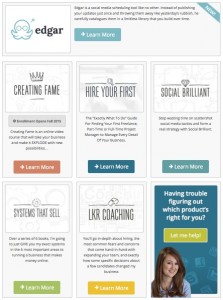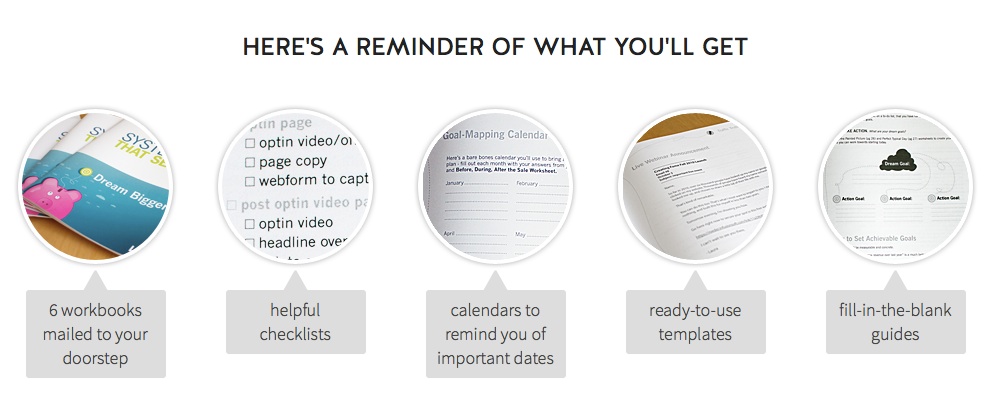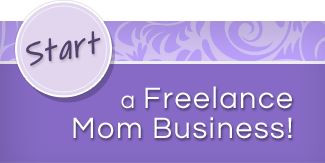
We looked last week at how Shenee Howard grew her business from $0 to six figures in two years, but now lets turn to an even larger and more exponential success: Laura Roeder.
From Service Provider to Seven-Figure Business Owner
Originally a web designer, Laura found that she spent a lot of time in her client conversations explaining how a client’s website should fit into the company’s overall social media strategy. Shocked that this was not typical stock in trade for designers, she let go of all of her clients in 2008 and launched 100% into social media consulting.
When she first started on this path, Laura made as much with her first webinar launch as she typically did with one to two web design contracts, except she found that she not only had a product she could use again, but also customers who still needed her. Her next big launch netted $27,000, but required a month of promotion (not to mention the time building the product) along with eight weeks of live webinars and email support for the course.
In 2010 at 26, she was already making nearly $200,000 a year through a combination of consulting and online courses, but Laura found herself in the position that all successful service providers, no matter how high their prices or how long they’ve been in business, find themselves in: one-to-one offerings create a necessary cap on earnings based on time available.
Since hitting her own personal brick wall, Laura has developed a system of product creation that allows her not only to grow her business profits by leaps and bounds and offer products that have the level of detail she’d offer in one-on-one consulting, but also to create more time for herself. Though this particular brick wall many would be happy to hit, the lesson still holds.
A quick note on this case study:
Keep in mind that I’m not saying that most Freelance Moms necessarily have a goal of making seven figures or hiring a whole staff to help us run our businesses.Many Freelance Moms started their businesses to work at their own pace and have more time with their families. Interestingly, Roeder set out with a similar goal, and you can read more about how that influences her outsourcing here.
That is ultimately what drove her to explore this particular type of product creation, and why I wanted to share it with all of you.
Think of Everything Your Customer Would Want: Add it All
 When you look at Laura’s online shop, it’s a little surprising:
When you look at Laura’s online shop, it’s a little surprising:
She’s only got five products.
One is brand-new (Edgar, at the top, which is still in limited roll-out) and one is not available at the moment. How does she make enough money to support a team of seven?
Her products are expensive and deservedly so. On Laura’s site, you can’t buy just one e-book. You buy six at once for $500. But after reading the table of contents for each book, you’ll probably find it so hard to choose that it’s not a far leap to get the whole set:
 Especially when you see all the useful study aids they come with:
Especially when you see all the useful study aids they come with:
If you have a need to organize and jump-start your business, these products appear to so completely cover everything to meet that need that it feels like (a) you’d be a fool not to buy it, and (b) these tools will meet every related need you’ll have for years to come because they are simply so complete.
The same goes for her flagship Social Brilliant course. The complete package is so complete, that whatever your learning style, she’s got you covered with:
- six step-by-step videos
- screenshot-, example-, and exercise-filled e-book
- back-stage tour videos
- library of fill-in-the-blank planners, spreadsheets and calendars
- advanced social media time-saving tips video course
- specific app and tool suggestion cheat sheet
- transcripts of all videos including screen shots, charts, and other videos
This kitchen sink approach has three key benefits:
- The product has so many bells and whistles it practically sells itself and content marketing is a breeze
- A high price point is not only a given but easily justified to the prospect
- Creating such value through pre-built information products shows that the value of actual interaction with Laura, either one-on-one or through ask-me-anything calls and webinars is incredibly high
The last point here is key for Freelance Moms looking to provide value while keeping their hours down. The higher the value you demonstrate in your products, the more people are prepared to pay for things that actually require you to directly exchange time for money.
And, by keeping her store relatively simple, Laura cuts down on customer service time, and ensures that the questions she receives will fall into standard buckets, saving her (or her assistant) time answering questions.
Forget Upselling & Downselling: Aim for Custom Fits
We’ve talked a few times here on FreelanceMom about “Goldilocks” pricing, or when you offer three different packages designed to push most customers toward the middle option.
Laura has a different approach however. We looked above at how she prices products that have a one-off purchase approach. What about products that rely on subscription pricing and sales?
In many different businesses that sell the majority of their products in the last few years, subscription-based websites have become a key money maker for small businesses, creating a highly desirable stream of dependable income.
Why offer just one price?
Many online marketing businesses following this model, namely the A-List Blogger Club, Freelance Writers Den, and now, Boost Blog Traffic’s Serious Bloggers Only!, but they pretty much all come at the same price point of $25-29 per month.
It’s almost like everyone got together and decided this was what the market would bear.
Laura, on the other hand, approaches her recurring pricing like software and app subscriptions: offering different rates depending on the size of your need:
When you think about it, it makes perfect sense that a larger business that will be accessing a product or forum more should pay more. Yet few people in the information product or service business are doing this. Why?
Many coaches offer one package, more or less, for their coaching in terms of the number of calls per month, the length of each call, and the amount of interim email support. If someone wants half the number of calls or half the length, you halve the price.
But why not create packages like:
- Start-up business coaching – $4000/month: four half-hour calls per week, including Monday morning motivation call and Friday weekly wrap-up, on-going email support for business troubleshooting
- Small business strategizing – $1500/month: one 60-minute call per week, email progress check-ins every other day
- Life coaching – $500/month: two 60-minute calls per month, email support to follow up on action items discussed during bimonthly call
Following Laura’s lead, how can you simplify your products and services to greater success today?







